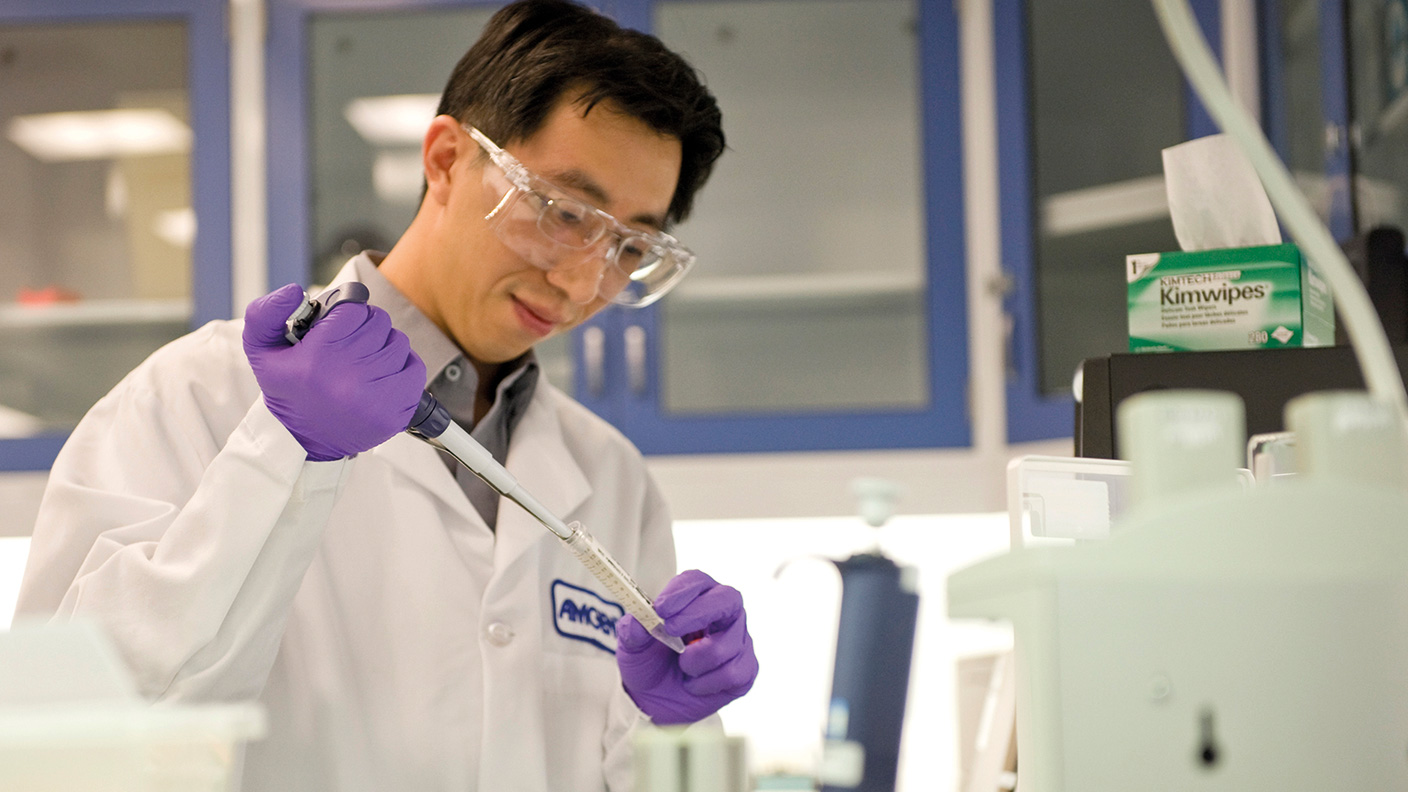How to invest in biotechnology: the healthcare sector’s high-growth area
Dr Mike Tubbs provides an overview of this thriving industry, whose latest triumphs include the Covid-19 vaccines. He examines the best investment strategies and highlights his favourite picks.


Biotechnology is a vast field – and a lucrative one for investors. It is concerned with harnessing biomolecular processes (involving lipids, cells, nucleic acid and proteins) to develop technologies and products. Over the last few decades the sector has revolutionised drug development, agriculture and aspects of green energy.
Early investors in biotech companies have done very well. Shares in Amgen (a large drug maker), for instance, have soared by a factor of 170 over the last 31 years; Genus – a UK animal-genetics group – is up 54-fold in the last two decades.
The industry’s successes include new and effective treatments for cancer, cures for serious genetic diseases and the recent development of several Covid-19 vaccines at record speed. Both the Pfizer/BioNTec and Moderna vaccines use synthetic mRNA, a technique applied to fighting cancer. It adapts the body’s natural RNA, which governs protein production in the cells.
MoneyWeek
Subscribe to MoneyWeek today and get your first six magazine issues absolutely FREE

Sign up to Money Morning
Don't miss the latest investment and personal finances news, market analysis, plus money-saving tips with our free twice-daily newsletter
Don't miss the latest investment and personal finances news, market analysis, plus money-saving tips with our free twice-daily newsletter
When the vaccine, comprising mRNA and the spike protein from the surface of the virus, is injected into the body, it prompts cells to start producing antibodies (proteins developed by the body to defend the immune system) to fight the virus. The AstraZeneca/Oxford vaccine, meanwhile, uses a harmless carrier virus with extra genetic material of the Covid-19 spike protein, which again stimulates antibody production.
Going beyond drugs
Biotech stretches far beyond vaccines, however. Increased crop and farm-animal yields are needed to feed a growing world population. This drives agricultural biotechnology. There are four big agribusinesses providing crop protection, fertilisers and genetically improved seeds. These are BASF, Bayer/Monsanto, Dow/DuPont (whose agricultural part was spun off as Corteva) and ChemChina/Syngenta.
Several agricultural biotech start-ups have already been acquired by the majors, including AgraQuest and TPG Growth (both bought by Bayer) and Becker Underwood (a seed-treatment specialist),scooped up by BASF. Genus is the world leader in genetics for farm animals.
Industrial biotech includes areas such as harnessing enzymes (biological catalysts) to improve products; biomatter power facilities; biofuels; waste-to-energy facilities and the biodegradation of plastics. Novozymes is a good example of a diversified industrial-biotech company with products in enzymes (for household detergents, for example); food and beverages (baking and brewing); bioenergy (bioethanol); and agriculture and feed (animal-feed enzymes and biopesticides).
However, it is the therapeutic biotech companies that have made the most rapid progress. The past few years have seen new biotech drugs for diseases such as cancer, autoimmune diseases and inherited genetic disorders. The companies developing new drugs range from well-established pharmaceutical firms with biotech divisions to large biotech companies and a range of smaller biotechs developing specific new treatments that they usually exploit through partnerships with big biopharma firms.
The key players
The large therapeutic biotechs include Amgen (it specialises in oncology, cardiovascular, inflammation and other diseases), Biogen (multiple sclerosis and neurological diseases), Gilead Sciences (HIV, liver diseases and cancer) and Celgene (a blood-cancer specialist acquired by Bristol-Myers Squibb in late 2019). There are several large pharma groups with big biotech divisions.
Roche, for instance, took a majority stake in Genentech, the first large US biotech, in 1990 and then acquired the remaining shares for $47bn in 2009. Bristol-Myers Squibb has joined this group via its acquisition of Celgene; AstraZeneca through its 2004 acquisitions of Cambridge Antibody Technology and 2007 acquisition of Medimmune; and Johnson & Johnson (J&J) due to takeovers of Janssen Pharmaceuticals, Crucell, Actelion and others. Most other large pharma firms have made smaller biotech purchases or bought late-stage drugs from smaller biotechs.
The smaller biotechs divide into three groups: those large enough to launch their own new drugs; those that enter partnerships with large pharmaceutical firms, whose massive sales forces agree to market some or all of their late-stage pipeline drugs; and those acquired by Big Pharma.
A good example of the first category is Vertex Pharmaceuticals, whose shares rose from $79 in early 2017 to $211 in May 2021; one growth driver was the launch in 2019 of its drug Trikafta for cystic fibrosis. It generated sales of $1.2bn in Q1 2021. MorphoSys, the antibody company, is an excellent example of the second group. It develops antibody drugs, which it commercialises in partnership with big pharmaceutical firms. It has 16 antibody drugs in 45 clinical trials with 12 Big Pharma partners.
MorphoSys’s first US-approved treatment was Tremfya, a treatment for psoriasis and psoriatic arthritis. It was launched four years ago. Examples of the third group include Gilead’s acquisition of Kite Pharma for $11.9bn to strengthen its cancer pipeline.
How a picks-and-shovels approach can pay off
The term “picks and shovels” was coined during the Californian gold rush when most money was made by firms supplying picks, shovels and other mining equipment rather than by prospectors, only a small proportion of whom found worthwhile amounts of gold. In this context, picks-and-shovels companies are those providing biotechs with the tools to carry out research and development. They tend to be lower-risk investments, since biotech researchers need these tools regardless of whether their projects are successful.
Excellent examples include Illumina and Abcam. Illumina is the market leader in next-generation DNA and RNA genetic-sequencing equipment, which can sequence either selected parts of a genome (the genetic material in an organism), or the whole genome. The widespread use of genomic sequencing results from the massive reduction in sequencing costs facilitated by technological advances. The first human genome was sequenced in 2000 and cost $2.7bn. Today a whole genome can be sequenced for $1,000.
Next-generation sequencing has wide therapeutic applications ranging from cancer and reproductive health to genetic and rare diseases and vaccines, notably Covid-19-variant sequencing. Illumina has an agreement to acquire full ownership of cancer-testing group Grail for $8bn.
Grail has developed a multi-cancer blood test that can identify different types of cancer at an early stage using tumour-genome analysis. This promises to revolutionise the early diagnosis of cancer and dramatically raise the chances of a cure.
Abcam, one of the largest companies on Aim, London’s junior market, provides the antibodies, other proteins and consumables (such as biochemicals and reagents) used in biotech research. It has an excellent website selling both its own and third-party antibodies to global customers, causing it to become known as the “Amazon of antibodies”. Abcam provides a detailed technical data sheet for every product so customers can select the best antibody or protein for their research project.
Picking cores and satellites
Since biotech is a broad field, investors usually want some exposure to the main areas of biotech, such as therapeutic drugs, picks-and-shovels companies and possibly agricultural, and/or industrial biotech. This is best achieved using a “core-and-satellite” approach, where the core comprises substantial, established and profitable companies often paying dividends. Satellites consist of smaller, higher-growth companies with the prospect of faster, but riskier, capital growth. The relative sizes of the core and satellite proportions will depend on an investor’s appetite for risk.
A biotech portfolio is likely to consist mainly of therapeutic biotech companies. When assessing these it is not sufficient just to look at recent financial results, since the company might make most of its profits from one successful drug facing increased competition or patent expiry. It is also important to analyse each company’s new drug pipeline to ensure that it has the potential to grow profitably in future.
So which companies have nurtured healthy pipelines? If we look at the top-ten drugs of 2019 by worldwide sales, we see that six are for cancer and two for immunology (diseases such as rheumatoid arthritis and psoriasis fall into this category).
Research group Evaluate Pharma’s estimate of what the top-ten bestselling prescription drugs will be in 2026 lists the bestselling one from Merck, the next two from Bristol-Myers Squibb, the fourth from Gilead and one each from AbbVie/J&J, Pfizer, AstraZeneca, Sanofi, Vertex and Novo Nordisk. Worldwide sales of cancer drugs in 2026 are estimated to be $311bn, with the next largest disease area being anti-diabetic drugs, with $67bn in global sales. These are followed by immunosuppressants with $61bn, vaccines ($56bn) and anti-rheumatics ($50bn). This shows the importance of having a portfolio well stocked with promising cancer drugs.
The top trusts and funds
Many investors are likely to gain biotech exposure through biotech or biopharma investment trusts or funds. In this case investors rely on the fund selecting an appropriate mix of core and satellite companies. There are several pure biotech investment trusts and others including both biotech companies and larger pharmaceutical companies.
There are only nine healthcare trusts with a four- or-five-star rating from investment-research and fund platform Morningstar (meaning a trust should outperform its peers). A good example of a four-star biotech/pharma trust is the Worldwide Healthcare Trust.
Its top-ten investments include four big-pharma companies (Bristol-Myers Squibb, Merck, Novartis, AstraZeneca), three smaller biotechs (Horizon Therapeutics, Mirati Therapeutics, Vertex) and a wide-ranging healthcare-products company (Boston Scientific).
Contrast this with two five star-rated biotech trusts, the Biotech Growth Trust and the International Biotechnology Trust, which are focused on pure biotech. BIOG’s top-ten investments include two large biotechs (Amgen and Biogen) and eight smaller ones, including Horizon and Vertex, which are also in WWH’s top ten. IBT’s top ten include two large biotechs (Amgen and Gilead Sciences) together with eight smaller biotechs including Horizon and Vertex.
These three trusts have rather different yields, discounts/premiums to net asset value (NAV), sizes and charges. BIOG and IBT have no dividend and currently sell at discounts to NAV of 0.1% and 0.6% respectively. WWH offers a yield of 0.68% and sells at a 1% discount. BIOG has a market value of £556m and boasts total return of 18.1% per year over the last five years. WWH’s market capitalisation is £2.4bn and it has returned an annual 17.1% per year over the last five years.
IBT’s market cap is £288m and it has produced annual returns of 15.2% over the past half decade. Ongoing charges vary from 0.88% for WWH to 1.1% for BIOG, to 1.29% for IBT. These three trusts are all well diversified and relatively low risk; WWH is the least risky.
An interesting high-risk addition to these trusts is Arix Bioscience. Arix invests in and builds unlisted biotechs making cutting-edge advances in life sciences. It has investments in 13 companies. Arix is small, with a market value of £253m at a recent share price of 190p. It is still unprofitable, but has cash of £44m and a three-year target of increasing NAV up to £500m. Arix could be a promising satellite investment. My favourite biotech investments, however, are outlined below.
The stocks and funds to buy now
Healthcare finished a year in the top three of the S&P 500’s 12 major sectors on six occasions between 2007 and 2017. Most other sectors recorded only two or three years in the top three. In addition, healthcare’s worst year was when it saw a 22.8% decline. Only consumer staples did better, with a slide of 15.4%; all other sectors recorded falls ranging from 29%-55%. This demonstrates the strong performance of healthcare and its defensive nature in bad years – good reasons why it should feature prominently in your portfolio. And biotechnology is the high-growth area of healthcare.
A smaller investment portfolio is likely to contain the Worldwide Healthcare Trust (LSE: WWH) or the Biotech Growth Trust (LSE: BIOG) to gain diversified exposure to healthcare or biotech respectively with relatively low risk. A larger portfolio may well have a section devoted solely to biotech, which is organised as a collection of core-and-satellite picks, but with the aim of still being moderate risk.
In this case the core constituents could be chosen from large biotechs such as Biogen (Nasdaq: BIIB) and Gilead Sciences (Nasdaq: GILD), a picks-and-shovels company such as Illumina (Nasdaq: ILMN), Abcam (Aim: ABC) or Thermo Fisher Scientific (NYSE: TMO), and a biotech-oriented pharmaceutical company such as Bristol-Myers Squibb (NYSE: BMY), Merck (NYSE: MRK), or AstraZeneca (LSE: AZN). Biogen is a leader in neuroscience, while Bristol-Myers Squibb, Merck and AstraZeneca spearhead cancer research. Gilead also has a strong cancer-drug pipeline. Diabetes is well covered by Novo Nordisk (Copenhagen: NOVOB), while AbbVie (NYSE: ABBV) concentrates on rheumatoid arthritis and immunology.
The satellites could be chosen from firms with substantial pipelines, such as MorphoSys (Frankfurt: MOR), Vertex Pharmaceuticals (Nasdaq: VRTX), Genus (LSE: GNS), Neurocrine Biosciences (Nasdaq: NBIX), Curis (Nasdaq: CRIS) and Keros Therapeutics (Nasdaq: KROS). It is important to select a set of firms whose products and pipelines cover a range of serious diseases. MorphoSys has as the largest proportion of its pipeline clinical trials for cancer, followed by immunology. Vertex focuses chiefly on cystic fibrosis, but its pipeline has potential drugs for seven other diseases. Genus is concerned with farm animal genetic-improvement programmes – both via breeding and by gene editing – to improve disease resistance. Neurocrine has four approved drugs and pipeline drugs for Parkinson’s, schizophrenia, depression and epilepsy. Curis focuses on oncology with one marketed drug. Keros is an example of a small biotech with no approved drugs, but three promising compounds in its pipeline.
In a still larger portfolio, the satellites could include smaller, riskier biotechs such as Keros, with pipelines having a small number of clinical trials in progress. Diversified exposure to unlisted companies could be added through an investment in Arix Bioscience (LSE: ARIX).
The price/earnings (p/e) ratios of the large biotechs are quite reasonable, with Biogen on 14.8 for 2021, Gilead on 9.3 and Bristol-Myers on 8.6. Picks-and-shovels stocks have p/es ranging from Thermo Fisher’s 21.2 to Illumina’s 63 and Abcam’s 65 (for 2022). Vertex is on 19.4, Horizon 24.5 and Genus 65 (for 2022). The large biotechs offer good value, says Morningstar, with Biogen’s shares at $272 compared with Morningstar’s fair-value estimate of $350, Gilead at $66.5 (fair value of $81) and Bristol Myers-Squibb at $64.50 ($68). Vertex costs $212 ($295). Illumina’s price at $377 is 10% above its fair value of $343.
Get the latest financial news, insights and expert analysis from our award-winning MoneyWeek team, to help you understand what really matters when it comes to your finances.
Highly qualified (BSc PhD CPhys FInstP MIoD) expert in R&D management, business improvement and investment analysis, Dr Mike Tubbs worked for decades on the 'inside' of corporate giants such as Xerox, Battelle and Lucas. Working in the research and development departments, he learnt what became the key to his investing; knowledge which gave him a unique perspective on the stock markets.
Dr Tubbs went on to create the R&D Scorecard which was presented annually to the Department of Trade & Industry and the European Commission. It was a guide for European businesses on how to improve prospects using correctly applied research and development.
He has been a contributor to MoneyWeek for many years, with a particular focus on R&D-driven growth companies.
-
 The return of Erik Prince, America's notorious mercenary
The return of Erik Prince, America's notorious mercenaryErik Prince, founder of the controversial private military group Blackwater, was shunned for pushing the boundaries of legality. He has re-established himself
-
 MoneyWeek news quiz: How much can you win in Premium Bonds?
MoneyWeek news quiz: How much can you win in Premium Bonds?Quiz Premium Bonds, ChatGPT, and the start of the festive season all made headlines this week. How closely were you following the news?
-
 Big Short investor Michael Burry closes hedge fund Scion Capital
Big Short investor Michael Burry closes hedge fund Scion CapitalProfile Michael Burry rightly bet against the US mortgage market before the 2008 crisis. Now he is worried about the AI boom
-
 The global defence boom has moved beyond Europe – here’s how to profit
The global defence boom has moved beyond Europe – here’s how to profitOpinion Tom Bailey, head of research for the Future of Defence Indo-Pac ex-China UCITS ETF, picks three defence stocks where he'd put his money
-
 Profit from a return to the office with Workspace
Profit from a return to the office with WorkspaceWorkspace is an unloved play on the real estate investment trust sector as demand for flexible office space rises
-
 New frontiers: the future of cybersecurity and how to invest
New frontiers: the future of cybersecurity and how to investMatthew Partridge reviews the key trends in the cybersecurity sector and how to profit
-
 An “existential crisis” for investment trusts? We’ve heard it all before in the 70s
An “existential crisis” for investment trusts? We’ve heard it all before in the 70sOpinion Those fearing for the future of investment trusts should remember what happened 50 years ago, says Max King
-
 8 of the best properties for sale with wildlife ponds
8 of the best properties for sale with wildlife pondsThe best properties for sale with wildlife ponds – from a 16th-century house in the Ashdown Forest, to a property on Pembrokeshire’s Preseli Hills
-
 Why a copper crunch is looming
Why a copper crunch is loomingMiners are not investing in new copper supply despite rising demand from electrification of the economy, says Cris Sholto Heaton
-
 Where to look for Christmas gifts for collectors
Where to look for Christmas gifts for collectors“Buy now” marketplaces are rich hunting grounds when it comes to buying Christmas gifts for collectors, says Chris Carter
